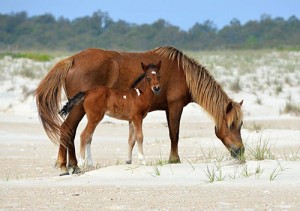
ASSATEAGUE — In what must be considered a baby boom, the size of the wild horse population on Assateague will likely increase this spring after the results of pregnancy tests conducted last fall revealed three mares are carrying foals.
While it certainly isn’t the most glamorous aspect of managing the famed wild horses on Assateague, a biological technician each year spends much of November conducting pregnancy tests of sorts on many of the mares on the barrier island in an attempt to predict how many, if any, new foals will join the herd in the coming year. The results of those tests were released last week and Assateague officials announced three of the mares on the island, including JoJo, Carol’s Girl, and Charmed are all expecting.
Assateague Island biological technician Allison Turner each year spends much of November following as many as 41 mares in the population of wild horses on the island waiting for them to defecate. The samples are collected, frozen and sent to a lab to be analyzed to determine if any of the mares will be expecting in the coming year.
For two decades or more, Turner has been carefully monitoring the birthing habits of the island’s most famous inhabitants and the information she collects tells the story for the coming year. Based on the collection of samples from 41 mares last fall, three are currently expecting, although it is difficult to predict just when the new additions will arrive.
Last May, JoJo gave birth to N6BMT-FN, the one and only foal born in the Maryland herd last year. N6BMT-FN is now named Jasper after a record-breaking on-line naming auction completed in January. The mares carry their babies for 11.5 months, so based on the birth of Jasper last May, her foal is not expected to arrive before May of this year at the earliest.
Assateague officials suspect Charmed was also pregnant last year, although she unfortunately lost that foal. Therefore, it is uncertain when her new foal will be birthed this year. Carol’s Girl is one of the most prolific mares in the Assateague herd, having birthed 11 foals. Carol’s Girl did not birth a foal last year, so it is difficult to predict when her foal might arrive this year. However, nine of Carol’s Girl’s 11 foals have been born in April May, or June, so it’s very likely her foal will arrive in that window again this year. As an interesting side note, most wild foals are born in the April to June window.
With three mares now expecting, 2016 could be a downright baby boom on the island. Just one foal, Jasper, was born on the barrier island in 2015 and the trend in the last several years has been one or two, or even zero in some cases. With the birth of Jasper last year, and the loss of a handful of older horses to illness or attrition, the size of the herd on the Maryland side currently stands at 88, which is well within the ideal range of 80 to 100.
In the interest of maintaining a healthy population size, the National Park Service several years ago began a contraceptive program for the mares in the herd. Selected mares are injected with a non-invasive contraceptive called PZP in an effort to maintain the size of the herd in its manageable threshold. However, some, including Carol’s Girl, for example, have proven to be resistant to the contraceptive.
Assateague’s contraceptive program has become the model for wild horse and other animal management programs around the country. As recently as just a few years ago, the size of the wild horse population on Assateague had swelled to around 140, or well north of the target range. However, with recent losses to old age, illness or other natural and man-made causes, NPS Resource Management has moved from the reduction phase to an adaptive management phase. From this point on, the results of the year-end pregnancy testing along with the estimated population will determine which, if any, mares will be darted with the contraceptive program.
